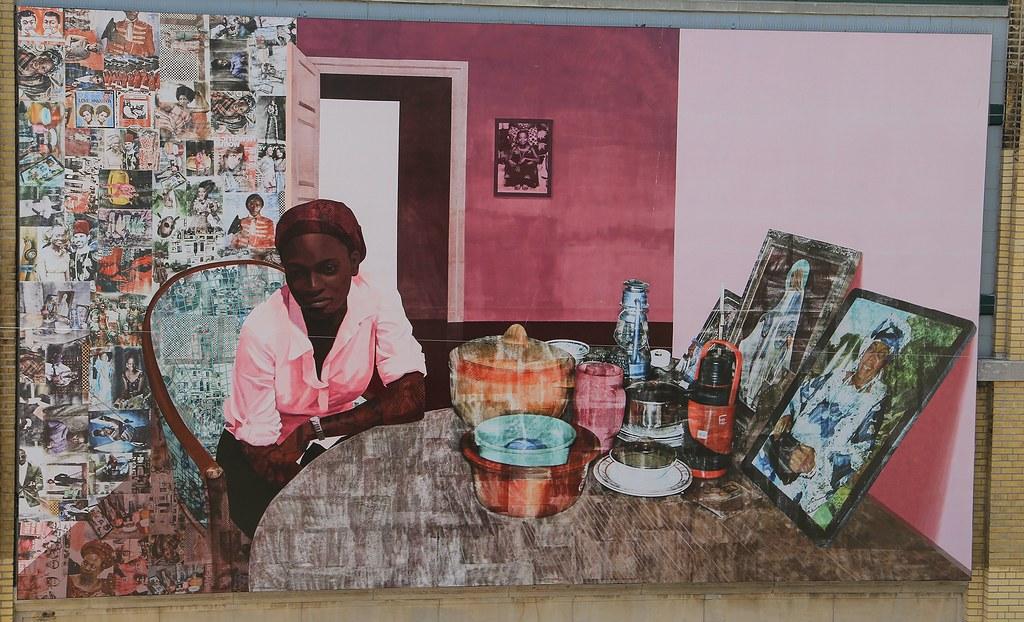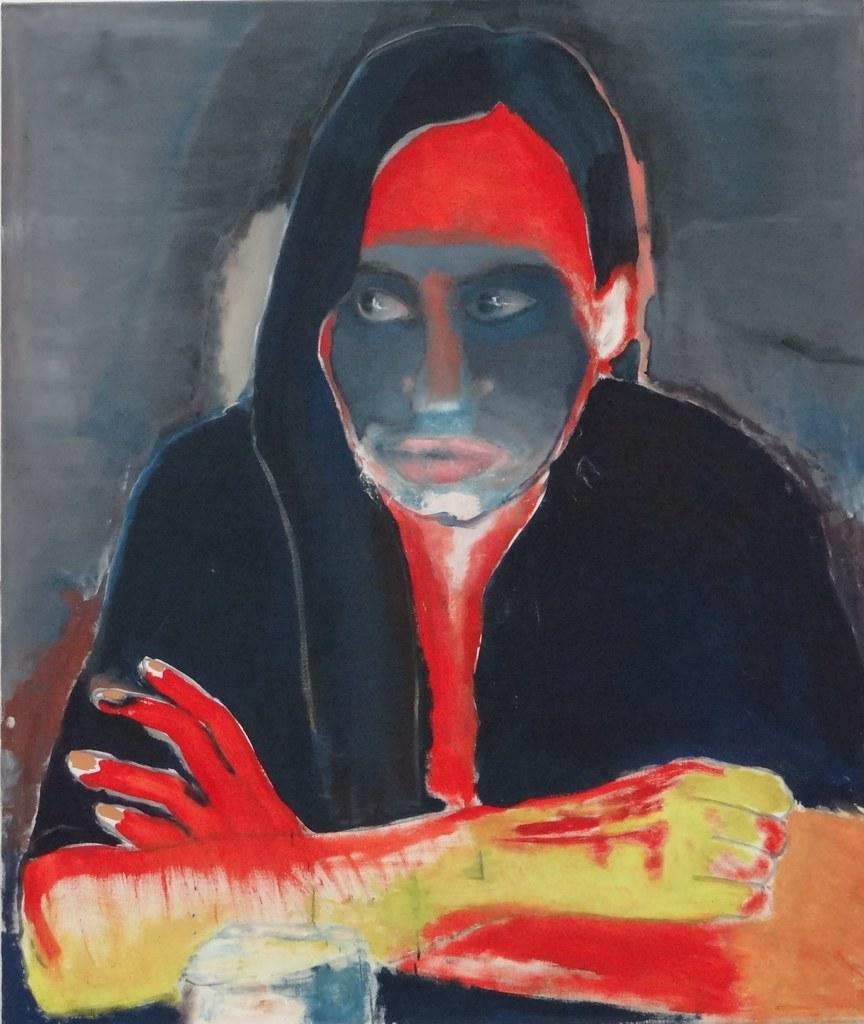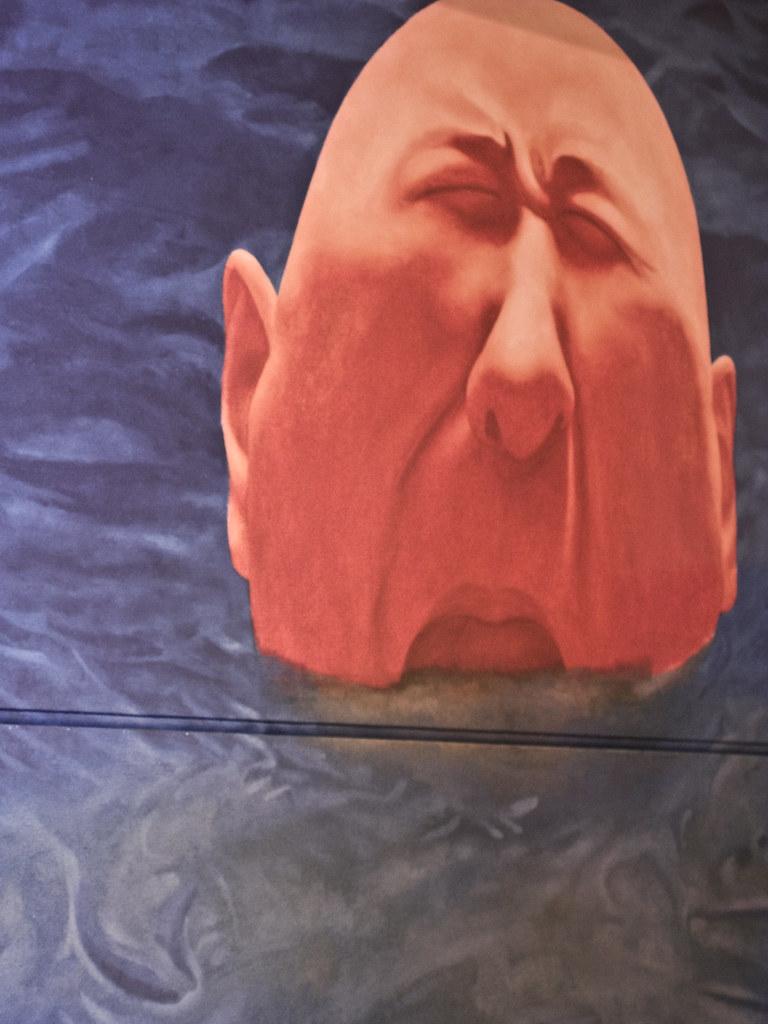15.5: Contemporary Figurative
- Page ID
- 32012
In the 20th century, figurative images were frequently ignored, the focus on the ever-changing abstract movements like Cubism or the Minimalists. As the 21st century began, figurative work resurged and expanded through multiple forms and expressions. Although the old masters set the standards, today’s figurative artists use the concepts of the past and earlier abstract movements to depict their own unique identities for the figure.
|
Name |
Native Country |
|---|---|
|
Njideka Akunyili Crosby |
Nigeria |
|
Marlene Dumas |
South Africa |
|
Zhang Xiaogang |
China |
|
Kerry James Marshall |
United States |
|
Jylian Gustlin |
United States |
|
Jenny Saville |
England |
|
Eric Fischl |
United States |
|
Kehinde Wiley |
United States |
|
Pablita Velarde |
United States |
|
Faith Ringgold |
United States |
|
Fang Lijun |
China |
|
Chantal Joffe |
England |
|
Amy Sherald |
United States |
Njideka Akunyili Crosby (born 1983) is from Nigeria before moving to the United States and attending the university to study medicine following the footsteps of her parents before changing directions to become an artist. In her work, she uses multi-media materials of paint, photos, fabric, and pencils. Crosby depicted scenes of everyday life in different rooms of the house, the kitchen, the table and chairs in the dining room, all adorned with images, pictures and things as part of the small details of one's life. Many patterns on the clothing, walls, or part of the furnishings reflect the colors and styles of her native Nigeria. Each painting is a story of life's events as one travels from room to room. A painting (15.73) from the series Portals, appears to be a young woman pondering the future, bringing the viewer into her room. Crosby’s work (Before Now After (Mama, Mummy, and Mamma) (15.74) depicts her relationship with her family, including images of her mother, grandmother, and sister, a table set with familiar family items and pictures.


Marlene Dumas (born 1953) was born in Cape Town, South Africa, where she studied art before moving to the Netherlands to study psychology. Dumas depicts her figures in dramatic concepts of love, death, or sexuality, sometimes intimate and controversial. Her brushstrokes are broad and loose and along with dark, brooding colors enhancing a distorted feeling to create the psychological and emotional images seen in Intimate Relations (15.75). Stern (15.76) portrays a woman who may be sleeping or perhaps deceased, an image giving the viewers choices, as does Losing (Her Meaning) (15.77), is the figure swimming or perhaps deceased.



Zhang Xiaogang (born 1958) was born in China and said his parents taught him how to draw early in his life to give him something to do and stay out of trouble, a skill he continued as an adult. His parents were removed from their home and placed in a re-education camp during the Cultural Revolution in China, an experience influencing his artwork today. He was able to attend the university, although he suffered from alcoholism at the time, another life-altering problem changing his life. He became part of a group of artists who were considered avant-garde, setting up their exhibitions until the events at Tiananmen Square ended liberal ideas. Much of his work today is based on families and the influence of past events as he created the stoic, flat, compliant characters, adding contrast with splotches of color. My Ideal (15.78) depicts a family, controlled by soldiers, with oversized heads and long noses. In his close-ups of individuals, Untitled (15.79), he used shadows, making the image slightly clouded, their oversized eyes staring outward, the black and gray image only highlighted by a splash of yellow.


Kerry James Marshall (born 1955) was born in Alabama but raised in Los Angeles. He received his BFA at Otis Art Institute and became a professor of art at the University of Illinois. The events of the time influenced Marshall, the Black Panthers, the Watts riots, the civil rights movements, and experiences of African Americans. His work reflects his study of history and the effects on the African American community, which he emphasizes by exaggerating the body with a deep black, a recognition of the usual recessed images of darker skin, bringing the color to the forefront. Untitled (15.80) depicts a female artist with an overly broad palette, facing the viewer with her painting behind her, a twist with the paint by number image. The Actor Hezekiah Washington as Julian Carlton Taliesen Murderer of Frank Lloyd Wright Family (15.81), is the image of an actor portraying a man who committed murder. The actor gazes out at the viewer, who is left with little knowledge of the person he pretends to be.
 15.80 Untitled
15.80 Untitled
15.81 The Actor Hezekiah Washington as Julian Carlton Taliesen Murderer of Frank Lloyd Wright Family
Jylian Gustlin (born 1960), born in California, lives in the San Francisco Bay Area, where she majored in art and mathematics before receiving her BFA. Although she includes mathematical expressions in her art, as seen in her Fibonacci series, her passion is the human figure and the fluidity and emotions of the figure. Sirens 3 (15.82) leaves the viewer guessing about the feelings exhibited between the three figures, all painted on a background of multiple layers of mixed media. Icarus (15.83) and Aphrodite 3 (15.84) both demonstrate the emotions of the figures, clouded in the background, faces turned from the viewer.



Jenny Saville (born 1970), one of the Young British Artists, received her degree from Glasgow School of Art. She spent some time studying in the United States, developing her views of women based on the numbers of large women she saw and how physically interesting she found their body shapes. Saville took the concepts of the body further based on how deformities could be corrected or what liposuction meant or how diseases affect the body, all taking her paintings to unusual proportions. She used patches of color and brushstrokes on large-sized canvases to create sensual skin and fleshy bodies. Strategy (15.85) displays the ample female forms demonstrating how many women appear, disparaging the myth of the runway model.

Eric Fischl (born 1948) lived in several parts of the United States after he graduated from college, eventually even teaching art for a while. Fischl often painted subjects set in suburbia, seeming to be performing everyday actions; however, many images were based on voyeurism by adolescents, or alcoholism in the country club life, displaying the contradictions found in the suburbs. In the Haircut (15.86), the viewer seems to be looking through the window at the young lady cutting her hair while sitting provocatively on her bed. Saigon, Minnesota (15.87) is a set of four panels depicting several people in the backyard that appears to be near a pool. Some of the people have a bathing suit; others are nude, lying, or sitting daringly, leaving the viewer to wonder what each of the groups is doing. Oddly, the people are relatively static while the dog seems to be running through the yard.


Pablita Velarde (1918-2006) belonged to the Santa Clara Pueblos and was sent with her sisters at an early age to a boarding school. As a teenager, she was able to attend an art school, one of the few female students. Velarde learned to paint in a flat style and used her skills to paint images to document and preserve the history of her people. At first, she used watercolors and later used natural pigments found in her area to grind and mix her paints, making earth paintings and is considered one of the outstanding female artists of the southwest. Basketmaking (15.88) portrays a man making a basket from yucca leaves as the man behind weaves a twilled basket. The woman is seated and preparing the materials the two men in the background have collected.

Kehinde Wiley (born 1977) was born in Los Angeles along with his twin brother, although early in their life, his father returned to Nigeria, leaving his mother to raise the children. Wiley was interested in art as a child and received a BFA from the Art Institute in San Francisco and an MFA from Yale. He was influenced by paintings from the old masters and incorporated their styles in combination with his interest in African and Islamic designs. Coming to Richmond (15.89) is an example of an African rider, sword in hand with horse rearing, very similar to paintings of Napoleon in the Alps. Wiley likes to use ordinary people as his models and often found people in the neighborhood to pose for him, then removing the person from the ordinary and placing the image in a composed environment with ornate backgrounds.
Mary Comforter of the Afflicted (15.90) is from a series of paintings Wiley created based on historical figures from old masters. He uses the images of young black men in similar poses who are standing in front of colorful backgrounds. Wiley was chosen to paint the official portrait for President Barack Obama, the first African American president. Wiley did not use the usual presidential poses, instead of placing the president in an ordinary chair nestled into a background of flowers. The colorful flowers had specific meanings to the president; chrysanthemums were the flower of Chicago; jasmine represents his birthplace of Hawaii and blue lilies for his father, who was from Kenya.

 15.90 Mary Comforter of the Afflicted
15.90 Mary Comforter of the AfflictedFaith Ringgold (born 1930) was born in Harlem, New York City, living in an area filled with artists, poets, writers, and musicians; her mother was a fashion designer. She learned to work with fabric from her mother, a medium she used extensively in her later artwork. After receiving her master's degree, Ringgold traveled to Europe, especially Paris, where she found the inspiration for the series, French Collection, her quilt paintings. She also visited West Africa, which motivated her construction of sculptures and masks. Her early works were based on some of the political unrest of the 1960s, and she created several series about the issues and problems of black Americans. Ringgold became well-known for her quilt and fabric paintings, sculptures, and masks. One of Ringgold's American People Series paintings was Die (15.91), well-dressed people demonstrating the hidden hostility existing in society and as blood splatters across the entire image, indicating everyone is affected by racism.

Fang Lijun (born 1963) was born in China, his family comfortable with its well-placed social status. As a child, he was trained in art and graduated from the Central Academy of Fine Arts. He became a member of the group Cynical Realism, artists who incorporated political issues into their art, especially human rights and suppression. Lijun used the bald head of people, focusing on faces to bring his message and develop the emotions and stories of each person as they may feel somewhat helpless in the overall society. Both of his images (15.92, 15.93), portray different emotions open for interpretation by the viewer.


Chantal Joffe (born 1969) studied at colleges in Scotland and England and currently paints women and children in large-scale works. She was inspired by the body positions and clothing of women and presented them in a form seemingly simplistic with unsettling characteristics, hinting at unseen and unsaid conflicts. She paints on oversized canvases with large brushstrokes, leaving drips of paints or outlines, the heads of her figures oddly shaped with piercing eyes. The woman in Green Dress, Black Knickers (15.94), appears to be looking into a mirror, or is there someone else in the room she sees. The Squid and the Whale (15.95), portrays a woman in her pants, sitting in front of a child. The feelings of the child are masked, a blanket held tightly. In the background, the green pillow anchors the two figures.


Amy Sherald (born 1973), who lives in Maryland, received her M.F.A. in painting, now focusing on documenting African Americans and their experiences in everyday life. She uses a form of grayscale or grisaille for the different skin tones of her images to defy the concept of color equals race. Grand Dame Queenie (15.96) depicts a woman holding a cup and saucer while she gazes at the viewer, her bright clothing symbolic of Sherald’s color palette. The Boy with No Past(15.97) displays a young man standing stiffly in his colorful clothing against a muted background. Both images depict individuals as important in their own right, challenging the viewers to recognize them. Sherald was selected to paint the official portrait, First Lady Michelle Obama (15.98). She used gray shades for Obama's skin tones as she is sitting in front of a plain blue background. Obama's white dress is a foil for patches of color, some of the squares similar to the quilts of Gee's Bend.





